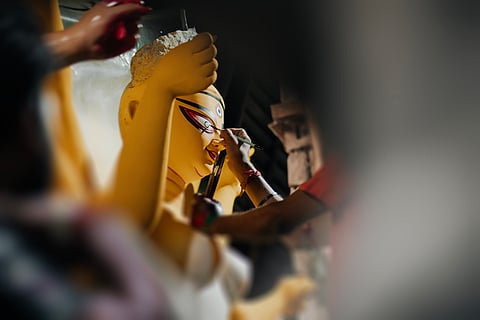Hailing women as goddesses is a time-tested patriarchal tool to deprive them of their essential rights
The veneration of female deities is a fundamental aspect of Hinduism. Each deity embodies various facets of women’s emotional traits such as sacrifice, knowledge, strength, destruction, compassion, companionship and responsibilities.
Among them, the idol of Goddess Durga has consistently inspired and represents the women’s strength.
The deity has always been invoked when women’s multitasking abilities are celebrated. Women engaged in their daily duties (which are arguably assigned obligations under the guise of femininity) are frequently referred to as Dasabhuja — or having 10 arms.
This comparison instils a feeling of pride in women, likening them to goddesses.
Eventually, this excessive veneration of women’s roles became a standard operating procedure which reeks of an instigation to oppress them under the guise of religion or the titles of mother, wife, daughter and sister.
Over time, this romanticised view of womanhood and the roles assigned to them have resulted in socio-economic inequalities.
Gender gaps in Indian workforce
The Indian economy is frequently criticised for its gender disparities. This gender gap is complex and varies across multiple factors. It is influenced by caste, geographic location, religious backgrounds, social norms, education levels, digital access and most significantly, income and job opportunities.
Women primarily drove the increase, and the labour force participation rate (LFPR) rose from 37 per cent in 2022–23 to 41.7 per cent in 2023–24.
According to the World Economic Forum’s Gender Gap Report 2024, LFPR for women is still below the global average of 47 per cent. This low representation of women in the Indian workforce is further highlighted by the adverse impact of climate change, which adds yet another factor to the already existing ones as if they weren’t sufficient.
Severe weather events like storms, floods, and heat waves are becoming more frequent, compelling countless individuals around the globe to abandon their homes.
As reported by UN Environment, 80 per cent of those displaced due to climate change are women or girls who encounter increased dangers of poverty, violence, or unplanned pregnancies while moving to safer areas.
A recent study indicates that women in India are considerably more at risk from extreme temperature conditions than men. Data collected since 2005 reveals a troubling increase in heat-related fatalities among Indian women, as reported in an analysis featured in Significance Magazine.
Climate change makes it worse
Climate change has the potential to exacerbate gender-based health inequities in India — a country experiencing rapid environmental transformation.
Because of biological, social, psychological and cultural reasons, men and women are affected differently by the health effects of climate change, which include increased exposure to heat, poor air quality, extreme weather events, changed vector-borne disease transmission, diminished water quality, and decreased food security.
These factors collectively influence health, workplace conditions, and women’s employment.
An internal study commissioned by the Ministry of Women and Child Development indicates that women and children in Bihar, Gujarat, Uttar Pradesh, Maharashtra, Madhya Pradesh, Andhra Pradesh, West Bengal and Telangana face significant vulnerabilities to disasters linked to climate change.
The marginalised groups and daily wage workers are significantly impacted, as extreme weather patterns adversely affect their health, resulting in increased absenteeism from work and loss of daily income.
Their low immunity, caused by inadequate nutrition and insufficient healthcare services, exacerbates these challenges. Pregnancy increases susceptibility as well.
Extended exposure to elevated temperatures is linked to stillbirth, congenital disabilities, and premature delivery — irrespective of the mother's age or ethnicity, with younger mothers facing an even greater risk of adverse results.
Furthermore, women face a greater likelihood of cardiovascular issues, supported by a recent study which found a significant correlation between the intima media thickness of arteries in women and ambient PM2.5 levels, while no such connection was observed in men.
India is facing a rise in extreme rainfall along with a decline in seasonal precipitation, leading to prolonged drought conditions. This situation worsens agricultural productivity, significantly impacting the food security of vulnerable populations.
Women, in particular, are inherently affected by the consequences of food scarcity and associated nutritional shortages because of their heightened requirements during menstruation, pregnancy, and breastfeeding. Additionally, the gender bias favouring males, and especially male children results in females and girl children being deprived of their nutritional needs.
Pregnant and breastfeeding women often decide to leave their jobs to protect themselves from the adverse impacts of erratic weather, which in turn reduces women’s participation in the workforce and further widens the gender gap. While the effects of climate change on women’s health have not been widely studied and examined, it will certainly be a significant concern for the female population in the years ahead.
Unfortunately, although a country where women take pride in the names of Durga, Laxmi and Saraswati, they experience deprivation stemming from a range of societal, economic, and physiological influences, and the effects of erratic climate patterns have rendered them even more susceptible to additional adversity.
Hence, linking women with goddess Durga may seem like a means to acknowledge and admire their daily contributions but it actually deprives them of their essential rights while offering superficial gestures like the imagery of the 10-armed goddess. Such an approach to acknowledge women’s contribution actually reinforces gender inequality.
Trishna Sarkar is an Assistant Professor (Department of Economics) at Dr BR Ambedkar College, University of Delhi
Views expressed are the author’s own and don’t necessarily reflect those of Down To Earth


